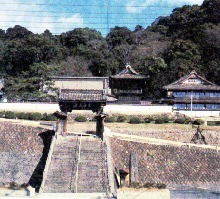www.tnewfields.info/sb/sei.htm
Copyright (c) 1997 by Tim Newfields and the Shizuoka City International Association
 Historic Sites in Shizuoka: [ MAP ]
Historic Sites in Shizuoka: [ MAP ]
Nestled in the foothills of Okitsu about fifty km. from Mt. Fuji, Seikenji's strategic location has played a paramount role throughout its history. In 679 Emperor Tenmu established a guard post here to protect his domains from barbarians in the north. At that time this area represented the northern frontier of Yamato culture. Even after barbarian tribes were driven further north, Seikenji became an inspection station along the Toukaidou Highway. Travelers passing by were required to pay a tributary tax to maintain the temple and assure public safety.
Seikenji Temple was originally associated with the Tendai sect of Buddhism. When the Kamakura shogunate seized power, Tendai teachings fell into disfavor and more spartan Zen teachings gained patronage by many warriors. In 1261 this temple became associated with the Rinzai sect of Zen. The temple was rebuilt and renamed "Kiyomigasekiji". Ashikaga Takauji, imperial regent, visited this temple and was impressed by its view of Mt. Fuji and Miho. He provided funding to expand the temple compound in 1347. For a period Seikenji was considered among the ten most magnificent temples in Japan.
During the turbulent middle ages, the Rinzai sect splintered into factions and when the Imagawa clan gained power, the Imagawa lord recommended that Seikenji join the Myoushinji faction. They promptly complied and the temple was well taken care of. Later Takeda Shingen rose to prominence and kept a garrison stationed there.
Tokugawa Ieyasu frequented Seikenji throughout his life. Today plum trees he planted still bloom in the temple courtyard. Much of the land around the Okitsu river was awarded to Seikenji in the Tokugawa era. By the end of the Tokugawa era, the temple was wealthy enough to support 49 monks and a staff of 13.
From 1782-87 a series of famines devastated this part of Japan. To help promote prosperity, five hundred statues of the disciples of Shaka-Nyorai were collected. At the time, it was hoped this devout act would change the weather. Many of the statues are now cracked or corroded from the ravages of age, yet their expressions are intriguing. Some resemble dwarfs from
Snow White or Yoda from Star Wars. Others resemble grumpy middle age men.
Among the treasures Seikenji boasts are paintings by Sesshuu Touyou and other prominent artists. Once a year in April they are placed on display.
Seikenji Temple is a 10-15 minute walk west of Okitsu JR Station. Yamanote line buses stop near the temple 2-4
times an hour during the day.